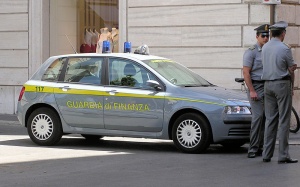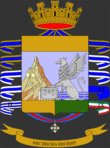Guardia di Finanza
The Guardia di Finanza, (/ˈgwardja di fiˈnantsa/) is an Italian military police force under the authority of the Minister of Economy and Finance. It is a part of the Italian Armed Forces as well as of the law enforcement agencies. It is also a military Corps. The Guardia di Finanza maintains over 600 boats and ships and more than 100 aircraft to fulfill its mission of patrolling Italy's territorial waters.
Its mission and institutional tasks are stated in the law 189 of April 23, 1959 and 68/2001 and are subdivided into priority ones (preventing, investigating and reporting financial evasions and violations, overseeing the compliance with the provisions of politico-economic interest and surveillance at sea for financial police purposes) and contribution ones (maintaining public order and safety and politico-military defense of the borders).
The Guardia di Finanza has around 68.000 policeman (agents, NCOs, officers). Its Latin motto since 1933 is Nec recisa recedit (Italian: Neanche spezzata retrocede; English: "Not Even Broken Retreats").
Its activities are financial, economic, judiciary and public safety: tax evasion, financial crimes, smuggling, money laundering, international illegal drug trafficking, illegal immigration, customs and borders checks, copyright violations , Anti-Mafia operations,credit card frauds, cybercrime, money counterfeiting, terrorist financing, maintaining public order and safety, political and military defense of the Italian borders. In Italy also the Guardia di Finanza has some duties of military police.

Special Departments of Guardia di Finanza
- Gruppo di Investigazione Criminalità Organizzata (GICO): Organized Crime Investigation Group.
- Gruppo Operativo Antidroga (GOA): Counter-narcotics Group.
- Gruppo Anticrimine Tecnologico (GAT): Counter-cybercrime Group.
- Commando Operativo Aeronavale (ROAN): Air-Naval Operational Command.
- AntiTerrorismo Pronto Impiego (ATPI): Antiterrorism and Rapid Response Service.
History
The origins of the Guardia di Finanza date back to October 5, 1774, when the “Light Troops Legion” was set up under the King of Sardinia, Victor Amadeus III. This was the first example in Italy of a special Corps established and organized for financial surveillance duties along the borders, as well as for military defense.
Once the unification of Italy was completed in 1862, the “Customs Guards Corps” was set up. Its main task was Customs surveillance and co-participation in the Country’s defense during war time. By Law no. 141 dated April 8, 1881, the Customs Guards Corps became the “Royal Guardia di Finanza Corps” whose task was to “impede,suppress and report smuggling activities and any other violation and transgression of financial laws and regulations”, and to safeguard the interests of the tax administration, as well as to co-participate in enforcing law and order and public security.
By Royal Decree dated July 14 1907, the Corps was issued 5-point star uniforms to mark its military status, even though the Army’s military discipline regulation was extended to the Guardia di Finanza by Law dated July 12 1908. The Corps served in the two World Wars and in the War of National Liberation, deserving 18 awards to its War Flag, which had been granted in 1914 to decree the total integration among the Country’s Armed Forces.
Subsequently, the Corps took part in numerous rescue operations during serious natural disasters; for this commitment the Corps was decorated with 13 additional civil valor awards.
The re-organization of the Police Forces in 1919 also affected the Royal Guardia di Finanza. The responsibilities were divided between the Inspector General, who was an Army Officer with the rank of Lieutenant General responsible for military preparation, and the Commanding General, who was a Guardia di Finanza Officer subordinate to the former, but authorized to maintain direct relations with the Minister for ordinary institutional duties and for personnel management. In 1923, the “Investigative Tax Police” was set up as a specialized branch of the Royal Guardia di Finanza. Within a few years, its naval fleet, motor-vehicles and telecommunication structure underwent a complete change; the Statistical Service equipped with a data processing centre, the Air Service and the Canine Service (for anti-drugs checks) were set up. During the same years, the Corps’ general organization was defined pursuant to Law no. 189 dated April 23rd 1959,which laid down its institutional tasks,subsequently amended by specific sector provisions assigning certain responsibilities.
Besides the review of its organizational structure, laid out by the issuance of Presidential Decree Law no. 34 dated January 29 1999, the updating of the Corps’ institutional tasks was completed. Law Decree no. 68, dated March 19 2001, whilst confirming the Corps’ configuration as a military structure, enhanced its role as a police force having general competence on all economic, financial and judicial matters for the safeguard of the public budget and that of the regions, of the local authorities and of the European Union.
The Guardia di Finanza Historical Museum is custodian of the traditions of the Corps. It preserves artifacts of relevance to the Guardia di Finanza and promotes historical research, to aid researchers, scholars and military history enthusiasts.
